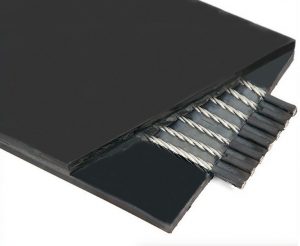Steel cord conveyor belt joint solution
There are four types of steel cord conveyor belt bonding: first-order, second-order, third-order and fourth-order lap. The choice of different overlap types is mainly related to the average effective distance, that is, the thickness of the adhesive layer between the two adjacent steel cords at the seam. In use, when the steel cord conveyor belt is subjected to stress or bending stress through the roller, the steel cord and the cord will be displaced due to factors such as tension and tension inconsistency. At this time, the change in the elongation of the adhesive is inversely proportional to the effective pitch of the steel cord arrangement. Therefore, the connection joint should consider the larger effective spacing value as much as possible, which is conducive to improving the tensile fatigue and bending fatigue of the joint parts. Under normal circumstances, the effective spacing of the steel cord at the joint must be greater than 0.25 times the steel cord diameter.
Due to the mixed overlap between the GX2000 belt and the ST/S2000 belt, the diameter, spacing and number of the steel cords of the two belts are different, resulting in a different arrangement of the steel cords at both ends of the joint than the joints of the same type of belt. The ST/S2000 belt has 19 more steel cords than the GX2000 belt, and must be evenly distributed in each step group. Therefore, the effective spacing between two adjacent steel cords at the joint is different. In order to ensure that there is sufficient effective spacing between each two adjacent steel cords at the joint, first calculate the effective spacing with the smaller steel cord spacing and the larger steel cord diameter, initially select the lap type, and then calculate the layout and actual effectiveness of the steel cord spacing.
The length of the joint determines the strength of the joint. The longer the joint length, the higher the joint strength. In general, the length of the joint is determined by calculating the bonding length of the steel cord according to the bonding force. Due to the different diameters of the steel cords of the two conveyor belts and the different adhesion, the length of the joint can only be determined by experiment. Samples with different lap lengths can be made from a set of steps and subjected to a destructive tensile test. The minimum step distance is 500mm, and the joint length of 1960mm meets the joint strength requirements.
Marking, cutting, steel cord cleaning and adhesive coating of the joints shall be carried out in accordance with the normal joint manufacturing methods. Because the thickness of the belts at both ends differ by 3 mm, the raw rubber can only be laid according to the thickness of the thick belt. During vulcanization, a 1000 mm 2 mm thick steel plate is added to the cooked conveyor belt at the end of the thin strip, and the thickness of the gasket is 21.5 mm to appropriately increase the compression ratio during vulcanization. The vulcanization condition is 14550 minutes. After vulcanization, cool to below 100, remove the film, trim the residual glue on the edge, and trim the steps formed by the flat pad.
After the destructive tensile test, the strength of the joint of the steel cord conveyor belt made by the above method can reach 100% of the strength of the belt body. The 800-meter conveyor belt after replacement has been running stably for more than 5 months, and there is no abnormal phenomenon, which proves that the selection method is normal and meets the safety production requirements of coal mines, avoiding the waste caused by the replacement of the entire line. It should be noted that the mixing of the steel steel cord with other strength grades can only be carried out on the basis of a comprehensive test

Tags: Steel cord conveyor belt










